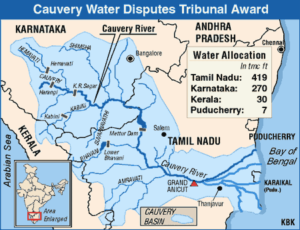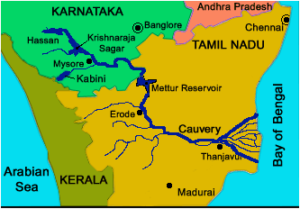The Cauvery Water Management Authority should act.
Relevance
- GS Paper-1 Water Resources.
- GS Paper- 2 Inter-State Relations.
- Tags: #KaveriWaterDispute #Karnataka #Tamil Nadu #CauveryWaterDisputeTribunal #Tribunal #CauveryWaterDispute #MekedatuReservoirProject #CauveryRiver #CAUVERYWATERMANAGEMENTAUTHORITY.
Why in the news?
- The CWMA, in its meeting on August 29, deliberated on many factors that included the shortfall in inflows and rainfall, the monsoon forecast over the next fortnight (till September 12), and inflows and outflows of four other reservoirs in the Cauvery basin. — an approach that has not been to the satisfaction of both States.
- While directing Karnataka to ensure the realisation of 5,000 cubic feet per second (cusecs) for 15 days from August 29, the CWMA recorded that during June 1 to August 27, the four Karnataka reservoirs had suffered a shortfall of 51.22% in their inflows, with the upper catchment of the Cauvery basin having had a more negative deficit in rainfall.
- The CWMA pointed out that the shortfall for Biligundulu, as compared to the stipulated flows in a normal year, was 62.4%.
- The Authority, which held an emergency meeting on September 18, endorsed the Cauvery Water Regulation Committee (CWRC)‘s direction given on September 12 to Karnataka to continue providing 5,000 cusecs for another 15 days.
Stands by the States
Karnataka
- Karnataka, which is not for considering only the deficit in inflows into its reservoirs, has been maintaining that the overall distress situation cannot be calculated till the end of January.
- It has said that the outcome of the northeast monsoon (October-December) should also be taken into account with that of the southwest monsoon (June-September).
- As an upper riparian State that is dependent on the southwest monsoon for irrigation, drinking water and more, Karnataka is well within its rights to be concerned about meeting its requirements for the next eight-odd months, even though it has the propensity to fix the “rules of the game” for water release unilaterally.
- It had even informed the Court of its difficulties in releasing water in view of a “severe drought situation” in the Cauvery and Krishna basins.
Tamil Nadu
- Tamil Nadu, which has worked out what is due to it this year, is waiting for the Supreme Court’s intervention to get back “its quota” of water for the one-and-a-half months even as the case is likely to be heard by the Court on September 21.
- Regardless of the outcome, the State should pursue the idea of judicious use of water.
Cauvery Water Dispute
About
- It involves 3 states and one Union Territory (Tamil Nadu, Kerala, Karnataka and Puducherry).
- The genesis of the dispute is 150 years old and dates back to the two agreements of arbitration in 1892 and 1924 between the then Madras presidency and Mysore.
- It entailed the principle that the upper riparian state must obtain consent of lower riparian state for any construction activity viz. reservoir on the river Cauvery.
Recent Developments
- From 1974, Karnataka started diverting water into its four newly made reservoirs, without the consent of Tamil Nadu resulting in a dispute.
- To resolve the matter, the CWDT (Cauvery Water Disputes Tribunal) was established in 1990 which took 17 years to arrive at the final order (2007) on how Cauvery water should be shared between the 4 riparian states in normal rainfall conditions.
- CWDT was constituted by the Central Government, in exercise of the powers conferred by section 4 of the Inter-State River Water Disputes Act, 1956.
- This was challenged in SC (Supreme Court) which directed Karnataka to release 12000 cusecs of water to Tamil Nadu prompting protests in the State.
- The final verdict of the SC came in 2018 where it declared the Cauvery a national asset and largely upheld the water-sharing arrangements finalized by the CWDT and also reduced the allocation of water from Karnataka to Tamil Nadu.
- As per the SC, Karnataka would get 284.75 thousand million cubic feet (tmcft), Tamil Nadu 404.25 tmcft, Kerala 30 tmcft and Puducherry 7 tmcft.
- It also directed the Centre to notify the Cauvery Management Scheme. The central government notified the ‘Cauvery Water Management Scheme’ 2018, constituting the ‘Cauvery Water Management Authority’ and the ‘Cauvery Water Regulation Committee’ to give effect to the decision.
Mekedatu Reservoir Project
- It aims to store and supply water for drinking purposes for the Bengaluru city. Around 400 megawatts (MW) of power is also proposed to be generated through the project.
- In 2018, Tamil Nadu approached the SC against the project even if Karnataka had held that it would not affect the flow of water to Tamil Nadu.
- TN is opposed to any project being proposed in the upper riparian unless it was approved by the SC.
River Cauvery
- It is known as ‘Ponni’ in Tamil, also known as Ganga of the south, and it is the fourth largest river of southern India.
- It is a sacred river of southern India. It rises on Brahmagiri Hill of the Western Ghats in southwestern Karnataka state, flows in a southeasterly direction through the states of Karnataka and Tamil Nadu, and descends the Eastern Ghats in a series of great falls and drains into Bay of Bengal through Pondicherry.
- Some of its tributaries are Arkavathi, Hemavathi, Lakshmana Theertha, Shimsa, Kabini and Harangi.
Cauvery Water Management Authority
- In exercise of the powers conferred by section 6A of the Inter-State River Water Disputes Act, 1956, the Central Government notified the Cauvery Water Management Scheme on 1st June, 2018, inter-alia, constituting the ‘Cauvery Water Management Authority’ (CWMA) and the ‘Cauvery Water Regulation Committee’ (CWRC) to give effect to the decision of the Cauvery Water Disputes Tribunal as modified by the Hon’ble Supreme Court Vide its Order, dated 16th February, 2018. CWMA & CWRC have so far carried out the mandated job as per the above Gazette notification successfully.
The main achievements of Cauvery Water Management Authority and Cauvery Water Regulation Committee up to 25.04.2022 are as under
- 61 meetings of CWRC were conducted for effective Monitoring of Hydro- meteorological situation in Cauvery Basin. Rules of Business of CWMA/ CWRC have been prepared and finalized.
- The Annual and Seasonal reports of water account for water years 2018-19, 2019-20 and 2020-2021 were prepared/ finalized by CWRC and the Annual and Seasonal reports of water account for water years 2018-19 and 2019-20 also approved by CWMA.
- Arrangement regarding monthly apportionment of 7 TMC of water to be released to UT of Puducherry by Government of Tamil Nadu was agreed by CWMA during its 5th meeting held on 25th February, 2020.
Way Forward
- The CWMA may not have shown its mettle so far, but it should now try and make a fresh beginning.
- To begin with, the Authority along with its assisting body, the CWRC, should make the proceedings of all its meetings held so far available to the public on a website.
- Putting out all the facts in the public domain will help the CWMA dispel misconceptions in both States about this issue given that the Cauvery has always been an emotive subject.
Source: The Hindu.
Mains Question.
Constitutional mechanisms to resolve the inter-state water disputes have failed to address and solve the problems. Is the failure due to structural or process inadequacy or both? Discuss.





